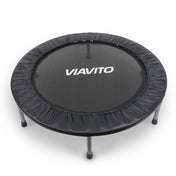We get it. You’re busy. You don’t have time to spend hours on your triceps or whole evenings on your quads.
But if you still want to achieve your fitness goals, isolation exercises are not always the most time efficient.
All you need is a full body workout that works around you. That means optimised workouts that continue to burn fat for over 24 hours after your workout, build lean muscle, and increase your overall stamina and cardiovascular fitness.
Why full body is best for time efficiency
If you’re a gym regular, you’ve probably heard that splitting your workout into arm and leg days is the norm.
Turns out, the opposite is true. Studies show that full-body workouts are as effective, as they train all your muscle groups more effectively and more often. This leads to more frequent growth stimulation in the muscles than working small groups of muscles on separate days. Plus it leads to more muscle growth over time.
And when a busy day consists of sitting at your desk, chasing after the kids or on an endless round of phone calls, who has time to dedicate a separate day to your arms, core or legs? Especially when you can get a fast, full body workout in 20-30 minutes that counteracts all the negative consequences of a busy yet sedentary lifestyle, while maintaining your mobility, functionality, strength, and cardiovascular health.
How HIIT aids muscle development
Combining high intensity exercises with short rests, the fitness and fat burning benefits of HIIT circuits make them the gold standard of fitness. But many fear that focusing on burpees and bear crawls will slow their muscle gains.
Here’s why they’re wrong.
First, cardio is necessary to increase your Vo2 max. High intensity exercises in circuit training push your body to its limits to maximise your aerobic respiration. Your muscles will use oxygen more efficiently, so you’ll lifting heavier, faster.
It depends on what cardio you do, too. HIIT circuits help you retain more muscle than moderate intensity continuous training (MICT) like jogging or cycling. Full body workouts ensure you use at least 80% of your muscles in one short workout, rather than 20-40% of your muscles in a regular treadmill or spin session.
Plus, during a HIIT workout, those fast-paced jumping lunges or high knees work your fast-twitch muscle fibres – which aren’t activated by lifting and as you get older, unfortunately if you don’t use them, you lose them.
Don’t forget the strength equipment though
Ever stopped yourself before a box jump, because you weren’t sure you would land it?
The cardio from a HIIT routine might push your stamina to its limits, but you’ll nail more mountain climbers a minute with resistance training.
Think of your cardio workout like your engine working on full blast. Your strength routine is what builds a bigger and better engine over time. By pushing yourself through a strength circuit that targets your whole body at once, you’ll build on your muscle foundations and reach your goals faster than cardio alone.
Plus, if one of your goals is fat loss, you can burn just as much in a strength circuit as in HIIT. A well designed resistance workout also leaves you with a high EPOC – all those compound squats to overhead barbell presses and deadlifts will raise your metabolism post workout for up to 38 hours.
A routine for mixing it up
This is tough, however you will be feeling the benefits for days after.
5 rounds, 4 minutes a round, 8 sets, 20 seconds on, 10 seconds off. Rest a minute between rounds.
Rounds 1, 3, 5 will be bodyweight focus. Rounds 2 to 4 incorporating equipment
- Interchange between mountain climbers and air squats
- Pick up a kettlebell. Interchange between kettlebell swings and kettlebell snatches
- Back to bodyweight. Interchange between burpees and pulse planks
- Pick up a barbell or dumbbells with desired weight. Interchange between deadlifts and cleans
-
The finisher. Interchange between press ups and jumping lunges
Feel free to start at a pace and a level suitable for you. Adding more weight when you feel necessary. For a harder challenge, why don’t you add a weighted vest into the mix?

